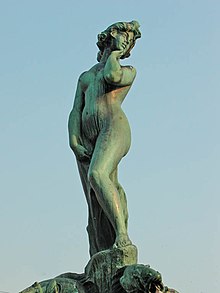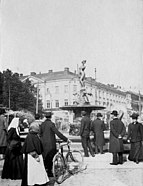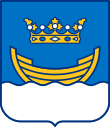Havis Amanda

Havis Amanda is a fountain and a statue in Helsinki, Finland by the sculptor Ville Vallgren (1855–1940). The work was modelled in 1906 in Paris, and erected at its present location at the Market Square in Kaartinkaupunki in 1908. Today it is recognized as one of the most important and beloved pieces of art in Helsinki.[1][2]
Sculpture[edit]
The Havis Amanda is one of Vallgren's Parisian Art Nouveau works. Cast in bronze, it rests on a fountain made of granite.[3] The sculpture is of a mermaid standing on seaweed as she rises from the water, with four fish spouting water at her feet, surrounded by four sea lions. Vallgren's intention was to symbolize the rebirth of Helsinki. The height of the statue is 1.94 metres (6 ft 4 in) and with the pedestal it stands 5 metres (16 ft) tall. According to Vallgren's letters the model for the statue was a then 19-year-old Parisian woman, Marcelle Delquini.[4]
Vallgren himself simply called the work Merenneito (English: The Mermaid),[5] but it quickly started to get additional nicknames. The Finland-Swedish newspapers dubbed it Havis Amanda and the Finnish Haaviston Manta or simply Manta. Havis Amanda is the common name used in brochures and travel guides.
History[edit]

Havin Amanda was unveiled on September 20, 1908. The work drew strong criticism at first,[6] especially from women.[4] Its nakedness and seductiveness were considered inappropriate. Not all groups objected to the nudity per se, but putting it on a pedestal was thought to subjugate women by sexually objectifying them and making them appear weak. Some women's rights groups criticised the look of the figure as plain or "a common French whore", lacking innocence. The sea lions, with their human tongues hanging out, were said to represent men lusting after the mademoiselle. Vallgren considered himself a worshipper of women. Many in the cultural elite of Finland considered Vallgren an outsider and had judged his work even before it was finished. A good friend of his, Albert Edelfelt, was instrumental through his influence in getting the work ordered.[7]
Every year on Vappu, Manta serves as a centrepiece for the celebrations. Students of the local universities place a student cap on the head of the statue in an elaborate ceremony called "Mantan lakitus" ("The capping of Manta").[4][8][9]
In 2002 Spencer Tunick organized a photoshoot of voluntary nude Finns, of whom almost 2000 showed up, posing around the statue as part of his Nude Adrift, Finland 3 project.[10][11] In 2014 artist Tatzu Nishi constructed a temporary hotel setting around the statue called Hotel Manta where visitors could see the statue in a new, unusual setting.[10][12][13]
There are fears of the old and hollow statue possibly breaking from people climbing on it. In 2019 there were calls from officials to limit celebrations and climbing on the statue.[14][15][16] During 2020's Vappu, out of concern for the COVID-19 pandemic, the city and the police decided to fence off the statue for the time being and directed the public towards a digital version of capping the statue.[10][17][18][19]
Gallery[edit]
-
Shortly after inauguration in 1908
-
After inauguration, 1908
-
In 1910s with a rental horse-drawn carriage parked in front
-
Russian soldiers on the fountain during Russian Revolution, 17 March 1917
-
Havis Amanda with a student cap, Vappu 1921
-
Vappu celebrators by the fountain in 1932
-
Late 1930s color view of the Market Square
-
Shielded during the Winter War, 1940
-
During Continuation War, Vappu 1944
-
Balloon-filled festivities in 1959–1960, with Erik Bruun's 1959 Jaffa palm tree poster in the background[20]
-
Elephants of the Swedish Circus Caravan drinking from the fountain in 1964
-
University students looking at coins collected from the fountain in 1965, with the large special cap on top of the coin bags
-
Children playing on a sea lion and a man throwing a coin, 1968
-
With snow on top, winter in the 1970s
-
Postage stamp from 1976
-
The fountain being cleaned after celebrations in 1983
-
TKK students having placed the student cap on Havis Amanda during the Vappu celebrations in 2002
-
Hotel Manta art installation by Tatzu Nishi in 2014
-
Havis Amanda in 2020, during the COVID-19 pandemic
-
Havis Amanda at the Helsinki Market Square in June 2020
See also[edit]
References[edit]
- ^ Becker, Ingeborg; Melchior, Sigrid (2002). Das Licht Kommt Jetzt von Norden: Jugendstil in Finnland /C[Katalog, Konzeption, Ingeborg Becker ; Redaktion, Ingeborg Becker, Sigrid Melchior]. Bröhan-Museum. ISBN 9783980789417.
- ^ Lindley, Phillip (1997). Sculpture Conservation: Preservation or Interference?. Scolar Press. ISBN 9781859282540.
- ^ Valkonen, Markku (1999). Finnish art: Over the centuries. Otava Pub. ISBN 9789511160809.
- ^ a b c "Havis Amanda". Helsinki Art Museum. Retrieved 29 May 2019.
- ^ Drost, Kurt (1968). "Finland in color: 30 photographs in color".
- ^ Lavery, Jason Edward (2006). The History of Finland. Greenwood Publishing Group. p. 80. ISBN 9780313328374.
havis amanda symbolizes.
- ^ Herrera, Arnulfo (2001). Amor y el desamor en las artes. Universidad Nacional Autónoma de México, Instituto de Investigaciones Estéticas. ISBN 9789683692115.
- ^ Öhtberg, Tony (2015). "Havis Amanda Will Be Crowned With a Show Unseen Before – View the Pictures From Last Year". Finland today. Retrieved 28 December 2016.
- ^ "Mayday reminder". Yle News. 30 April 2018. Retrieved 29 May 2019.
- ^ a b c Mononen, Sini (30 April 2020). "Havis Amanda on tänä vappuna aidattu turvaan, mutta sitä ennen veistos on nähnyt liki kaiken: Tällainen on kansakunnan puhutuimman patsaan historia". Helsingin Sanomat. Retrieved 11 May 2020.
- ^ "Spencer Tunickin Helsingin alastonkuvat valmistuivat". Ilta-Sanomat. 14 December 2002. Retrieved 11 May 2020.
- ^ "Hotel Manta of Helsinki (Temporary work - Removed)". HAM Helsinki. Retrieved 11 May 2020.
- ^ Dan Howarth (8 September 2014). "Tatzu Nishi builds Hotel Manta around a nude sculpture". Dezeen. Retrieved 11 May 2020.
- ^ "Helsinki deputy mayor appeals to revellers: Stop climbing historic statue". Yle. 28 May 2019. Retrieved 11 May 2020.
- ^ Malmberg, Lari (28 May 2019). "Kultajuhlien symboliksi noussut Havis Amanda -patsas on vaarallisen ohut ja hauras, kertoo museojohtaja –"Sehän on mittaamattoman arvokas"". Helsingin Sanomat. Retrieved 11 May 2020.
- ^ Laine, Linda (16 November 2019). "Juhlijoita pyydettin olemaan kiipeämättä Havis Amanda -patsaalle – toisin kävi: "Tulemme lähiaikoina arvioimaan vauriot"". Iltalehti. Retrieved 11 May 2020.
- ^ "Gallery: Helsinki's Havis Amanda statue fenced off to discourage May Day celebrations". Helsinki Times. 28 April 2020. Retrieved 11 May 2020.
- ^ Egutkina, Anna (29 April 2020). "Helsingin virtuaalisessa vapussa lakitetaan Havis Amandan patsas ja yleisö voi bailata JVG:n tahtiin: "Tällaista ei ole nähty Suomessa eikä maailmanlaajuisestikaan"". MTV Uutiset. Retrieved 11 May 2020.
- ^ "Havis Amandan lakki ilmestyi ilmasta – näin lakitus sujui virtuaalitodellisuudessa, jossa patsas oli epätavallisessa paikassa". Ilta-Sanomat. 30 April 2020. Retrieved 11 May 2020.
- ^ ""Jaffa Palm Tree", Hartwall 1959". Bruun Design. Retrieved 1 June 2020.
- Statues and sculptures in Helsinki
- Kaartinkaupunki
- 1906 sculptures
- Outdoor sculptures in Helsinki
- Art Nouveau sculptures and memorials
- Bronze sculptures in Finland
- Nude sculptures
- Sculptures of women
- Fountains in Finland
- Art Nouveau architecture in Helsinki
- 1908 establishments in Finland
- Walpurgis Night traditions










![Balloon-filled festivities in 1959–1960, with Erik Bruun's 1959 Jaffa palm tree poster in the background[20]](http://upload.wikimedia.org/wikipedia/commons/thumb/9/96/Teuvo_Kanerva_-_Photograph_of_the_statue_Havis_Amanda_on_Vappu.jpg/188px-Teuvo_Kanerva_-_Photograph_of_the_statue_Havis_Amanda_on_Vappu.jpg)










